Temporal and Spatial Differences in CO2 Equivalent Emissions and Carbon Compensation Caused by Land Use Changes and Industrial Development in Hunan Province
Abstract
:1. Introduction
2. Materials and Methods
2.1. Overview of the Study Region
2.2. Data Sources
2.3. Analysis Method
2.3.1. Land Use Change Rate
2.3.2. Calculation Method of CO2 Equivalent Emissions
- (1)
- Direct calculation method of CO2 equivalent emission
- (2)
- Indirect calculation method of CO2 equivalent emission
2.3.3. Carbon Compensation Model
3. Results and Analysis
3.1. Spatialtemporal Analysis of Land Use Change in Hunan Province
3.1.1. Characteristics of Land Use Change
3.1.2. Spatial Characteristics of Land Use Transformation
3.2. Spatiotemporal Characteristics of CO2 Equivalent Emissions in Hunan Province
3.2.1. Sequential Changes in CO2 Equivalent Emissions in Hunan Province
3.2.2. Spatial Characteristics of CO2 Equivalent Emissions in Hunan Province from 2000 to 2020
3.3. Influence of Land Use Change and Socio-Economic Factors on CO2 Equivalent Emissions
3.4. Accounting and Analysis of Carbon Compensation Value
4. Discussion and Conclusions
4.1. Discussion
4.2. Conclusions
- (1)
- Between 2000 and 2020, the net CO2 equivalent emissions from land use in Hunan Province increased and then decreased. Built-up land is the main carbon source, and its CO2 equivalent emissions increase by nearly 2.1 times. Forest land is the main carbon sink, and this carbon sink decreases with the reduction in forest land. The amount of carbon absorbed by carbon sinks is far lower than the carbon sources, which cannot achieve carbon balance and leads to large net CO2 equivalent emissions.
- (2)
- According to the spatial distribution of net CO2 equivalent emissions in Hunan Province, the areas with high net CO2 equivalent emissions are mainly distributed in the old industrial cities with large CO2 equivalent emissions and small carbon absorption, mainly in Yueyang, Xiangtan, and Loudi, while the areas with low net CO2 equivalent emissions are mainly distributed in Huaihua, Xiangxi, and Zhangjiajie with small CO2 equivalent emissions and widely distributed forest.
- (3)
- The carbon compensation value is highly similar to the spatial distribution of net CO2 equivalent emissions in each city. According to the different carbon compensation values of each city in Hunan Province, each city in Hunan Province can be divided into a high paid compensation area, low paid compensation area, high obtained compensation area, and low obtained compensation area. From the relationship between carbon emissions and carbon compensation value, the more carbon emissions, the more carbon compensation funds paid. On the contrary, the less carbon emissions, the more carbon compensation funds obtained. Therefore, to achieve regional coordinated development and low-carbon development, it is necessary to establish a government-led regional horizontal carbon compensation system, to continuously narrow the economic gap, strive to achieve fair development within the region, and rely on carbon compensation to promote regional low-carbon oriented development. In parallel, regions with high carbon emissions should also improve energy efficiency, adjust the energy consumption structure, and reduce carbon sources.
Supplementary Materials
Author Contributions
Funding
Institutional Review Board Statement
Informed Consent Statement
Data Availability Statement
Conflicts of Interest
References
- IPCC. Annex I: Glossary. In IPCC, 2022: Climate Change 2022: Mitigation of Climate Change. Contribution of Working Group III to the Sixth Assessment Report of the Intergovernmental Panel on Climate Change; Cambridge University Press: Cambridge, UK; New York, NY, USA, 2022. [Google Scholar]
- Mallapaty, S. How China could be carbon neutral by mid-century. Nature 2020, 586, 482–483. [Google Scholar] [CrossRef]
- Goldewijk, K.K.; Ramankutty, N. Land-cover change over the three last centuries due to human activities. Glob. Chang. Newsl. 2001, 47, 17–19. [Google Scholar] [CrossRef]
- Li, W.; Chen, Z.-J.; Li, M.-C.; Zhang, H.; Li, M.-Y.; Qiu, X.-Q.; Zhou, C. Carbon emission and economic development trade-offs for optimizing land-use allocation in the Yangtze River Delta, China. Ecol. Indic. 2023, 147, 109950. [Google Scholar] [CrossRef]
- Yi, W.-J.; Zou, L.-L.; Guo, J.; Wang, K.; Wei, Y.-M. How can China reach its CO2 intensity reduction targets by 2020? A regional allocation based on equity and development. Energy Policy 2011, 39, 2407–2415. [Google Scholar] [CrossRef]
- Meyfroidt, P.; Lambin, E.F.; Erb, K.-H.; Hertel, T.W. Globalization of land use: Distant drivers of land change and geographic dis-placement of land use. Curr. Opin. Environ. Sustain. 2013, 5, 438–444. [Google Scholar] [CrossRef]
- IPCC. Annex II: Definitions, Units and Conventions. In IPCC, 2022: Climate Change 2022: Mitigation of Climate Change. Contribution of Working Group III to the Sixth Assessment Report of the Intergovernmental Panel on Climate Change; Cambridge University Press: Cambridge, UK; New York, NY, USA, 2022. [Google Scholar]
- Ishii, S.; Tabushi, S.; Aramaki, T.; Hanaki, K. Impact of future urban form on the potential to reduce greenhouse gas emissions from residential, commercial and public building in Utsunomiya Japan. Energy Policy 2010, 38, 4888–4896. [Google Scholar] [CrossRef]
- Nijdam, D.; Rood, T.; Westhoek, H. The price protein: Review of land use and carbon footprints from life cycle assessments of animal food products and their substitutes. Food Policy 2012, 37, 760–770. [Google Scholar] [CrossRef]
- Campbell, C.A.; Zentner, R.P.; Liang, B.-C.; Roloff, G.; Gregorich, E.C.; Blomert, B. Organic C Accumulation in Soil over 30 Years in Semiarid Southwestern Saskatchewan-Effect of Crop Rotation and Feryilizer. Can. J. Soil Sci. 2000, 80, 179–192. [Google Scholar] [CrossRef]
- Cai, M.; Ren, C.; Shi, Y.; Chen, G.-Z.; Xie, J.; Edward, N. Modeling spatiotemporal carbon emissions for two mega-urban regions in China using urban form and panel data analysis. Sci. Total Environ. 2023, 857, 159612. [Google Scholar] [CrossRef]
- Liang, X.-L.; Liu, Z.-P.; Zhai, L.; Ji, L.; Feng, Y.-J.; Sang, H.-Y. Spatial terrestrial carbon emissions/sequestrations evolution based on ecological network analysis in Beijing-Tianjin-Hebei urban agglomeration. Ecol. Eng. 2023, 189, 106914. [Google Scholar] [CrossRef]
- Ma, L.; Xiang, L.-G.; Wang, C.; Chen, N.-C.; Wang, W. Spatiotemporal evolution of urban carbon balance and its response to new-type urbanization: A case of the middle reaches of the Yangtze River Urban Agglomerations, China. J. Clean. Prod. 2022, 380, 135122. [Google Scholar] [CrossRef]
- Ge, Q.-S.; Dai, J.-H.; He, F.-N.; Pan, Y.; Wang, M.-M. Research on China’s land use, land cover change and carbon cycle in the past 300 years. Sci. China 2008, 38, 197–210. [Google Scholar]
- Chen, Y.; Lu, H.; Li, J.; Xia, J. Effects of land use cover change on carbon emissions and ecosystem services in Chengyu urban agglomeration, China. Stoch. Environ. Res. Risk Assess. 2020, 34, 1197–1215. [Google Scholar] [CrossRef]
- Tian, M.; Chen, Z.; Wang, W.; Chen, T.; Cui, H. Land-Use Carbon Emissions in the Yellow River Basin from 2000 to 2020: Spatio-Temporal Patterns and Driving Mechanisms. Int. J. Environ. Res. Public Health 2022, 19, 16507. [Google Scholar] [CrossRef]
- Ji, X.-F.; Zhang, Y.-S.; Mirza, N.; Umar, M.; Rizvi, S.K.A. The impact of carbon neutrality on the investment performance: Evidence from the equity mutual funds in BRICS. J. Environ. Manag. 2021, 297, 113228. [Google Scholar] [CrossRef]
- Liu, X.-R.; Yang, L.; Wang, Y.; Zhao, J.-Y.; Li, Z.-X.; Wang, J.-J.; Wang, Q.-X.; Zhou, J. Assessment of carbon emissions based on land use change in Northeast China. Bull. Soil Water Conserv. 2017, 37, 107–114. [Google Scholar]
- Zhou, Y.; Zhao, W. Study on carbon emission accounting and low-carbon optimization of land use structure in Xi’an. Ecol. Econ. 2018, 34, 21–25. [Google Scholar]
- Zhou, X.; Wu, D.; Li, J.-F.; Liang, J.-L.; Zhang, D.; Chen, W.-X. Cultivated land use efficiency and its driving factors in the Yellow River Basin, China. Ecol. Indic. 2022, 144, 109411. [Google Scholar] [CrossRef]
- Eirik, O.J.; Torjus, F.B. Modelling emission and land-use impacts of altered bioenergy use in the future energy system. Energy 2023, 265, 126349. [Google Scholar] [CrossRef]
- Liu, T.-T.; Wang, X.-F.; Yuan, X.-Z.; Gong, X.-J.; Hou, C.-L. Spatial-temporal characteristics and driving factors of greenhouse gas emissions from rivers in a rapidly urbanizing area. Environ. Sci. 2019, 40, 2827–2839. [Google Scholar]
- Li, J.; Li, S. Energy investment, economic growth and carbon emissions in China-Empirical analysis based on spatial Durbin model. Energy Policy 2020, 140, 111425. [Google Scholar] [CrossRef]
- Zhang, H.; Gu, P.; Cao, G.; He, D.; Cai, B. The Impact of Land-Use Structure on Carbon Emission in China. Sustainability 2023, 15, 2398. [Google Scholar] [CrossRef]
- Meng, Q.; Zheng, Y.; Liu, Q.; Li, B.; Wei, H. Analysis of Spatiotemporal Variation and Influencing Factors of Land-Use Carbon Emissions in Nine Provinces of the Yellow River Basin Based on the LMDI Model. Land 2023, 12, 437. [Google Scholar] [CrossRef]
- Shahbaz, M.; Loganathan, N.; Muzaffar, A.T.; Ahmed, K.; Jabran, M.A. How urbanization affects CO2, emissions in Malaysia? The application of STIRPAT model. Renew. Sustain. Energy Rev. 2016, 57, 83–93. [Google Scholar] [CrossRef]
- Yang, Y.-J.; Li, H.-Y. Spatiotemporal dynamic decoupling states of eco-environmental quality and land-use carbon emissions: A case study of Qingdao City, China. Ecol. Inform. 2023, 75, 101992. [Google Scholar] [CrossRef]
- Li, H.; Zhao, Y.; Wang, S.; Liu, Y. Spatial-temporal characteristics and drivers of the regional residential CO2 emissions in China during 2000–2017. J. Clean. Prod. 2020, 276, 124116. [Google Scholar] [CrossRef]
- National Bureau of Statistics. China Statistics Yearbook (2021); China Statistics Press: Beijing, China, 2021. [Google Scholar]
- Zhou, S.-Y.; Xi, F.-M.; Yin, Y. Accounting and drivers of carbon emission from cultivated land utilization in Northeast China. Chin. J. Appl. Ecol. 2021, 32, 3865–3871. [Google Scholar]
- Cai, Z.-C.; Kang, G.-D.; Tsuruta, H.; Mosier, A. Estimate of CH4 Emissions from Year-Round Flooded Rice Fields during Rice Growing Season in China. Pedosphere 2005, 15, 66–71. [Google Scholar] [CrossRef]
- He, Y. Research on China’s Climate and Terrestrial Ecosystem Carbon Cycle; China Meteorological Press: Beijing, China, 2006. [Google Scholar]
- Shi, H.-X.; Mu, X.-M.; Zhang, Y.-L.; Lu, M.-Q. Effects of different land use patterns on carbon emission in Guangyuan city of Sichuan Province. Bull. Soil Water Conserv. 2012, 32, 101–106. [Google Scholar]
- Xiao, H.-Y.; Yuan, X.-Z.; Li, B.; Yan, W. Effects of land use change on the carbon emission—A case study of Chongqing. J. Chongqing Norm. Univ. 2012, 29, 38–42. [Google Scholar]
- Fang, J.-Y.; Guo, Z.-D.; Piao, S.-L.; Chen, A. Terrestrial vegetation carbon sink in China from 1981–2000. Sci. China 2007, 6, 804–812. [Google Scholar]
- Li, L.; Dong, J.; Xu, L.; Zhang, J.-F. Spatial variation of land use carbon budget and carbon compensation zoning in functional areas: A case study of Wuhan urban agglomeration. J. Nat. Resour. 2019, 34, 1003–1015. [Google Scholar]
- Lai, L. Carbon Emission Effect of Land Use in China; Nanjing University: Nanjing, China, 2010. [Google Scholar]
- Duan, X.-N.; Wang, X.-K.; Lu, F.; Ouyang, Z.-Y. Carbon sequestration and its potential by wetland ecosystems in China. Acta Ecol. Sin. 2008, 28, 463–469. [Google Scholar]
- Wei, Y.-R.; Chen, S.-L. Spatial correlation and carbon balance zoning of land use carbon emissions in Fujian Province. Acta Ecol. Sin. 2021, 41, 5814–5824. [Google Scholar]
- Fan, J.-S.; Yu, X.-F.; Zhou, L. Carbon emission efficiency growth of land use structure and its spatial correlation: A case study of Nanjing city. Geogr. Res. 2018, 37, 2177–2192. [Google Scholar]
- Liu, X.-Y.; Wang, Y.-F.; Song, Q.-J.; Qi, Y. Study on Carbon Emissions Sources in China’s Urbanization Process. China Popul. Resour. Environ. 2015, 25, 61–66. [Google Scholar]
- Paustian, K.; Ravindranath, N.H.; van Amstel, A.R. 2006 IPCC Guidelines for National Greenhouse Gas Inventories; IPCC: Geneva, Switzerland, 2006. [Google Scholar]
- IPCC. 2013 Supplement to the 2006 IPCC Guidelines for National Greenhouse Gas Inventories: Wetlands; Hiraishi, T., Krug, T., Tanabe, K., Srivastava, N., Baasansuren, J., Fukuda, M., Troxler, T.G., Eds.; IPCC: Geneva, Switzerland, 2014. [Google Scholar]
- Eggleston, H.-S.; Buendia, L.; Miwa, K.; Ngara, T.; Tanabe, K. 2006 IPCC Guidelines for National Greenhouse Gas Inventories; Preparation of the National Greenhouse Gas Inventories Plan: Tokyo, Japan, 2006. [Google Scholar]
- Lu, J.-Y.; Huang, X.-J.; Dai, L.; Chen, Z.G.; Li, Y. Spatio-temporal scale analysis on the equality of energy consumption carbon emission distribution in China. J. Nat. Resour. 2012, 27, 2006–2017. [Google Scholar]
- Zhao, R.-Q.; Liu, Y.; Ma, L.; Li, Y.-X.; Hou, L.-P.; Zhang, Z.-P.; Ding, M.-L. County-level carbon compensation of Henan Province based on carbon budget estimation. J. Nat. Resour. 2016, 31, 1675–1687. [Google Scholar]
- Zhao, R.-Q.; Zhang, S.; Huang, X.-J.; Qin, Y.C.; Liu, P.; Ding, M.; Jiao, S. Spatial variation of carbon budget and carbon balance zoning of Central Plains Economic Region at county-level. Acta Geogr. Sin. 2014, 69, 1425–1437. [Google Scholar]
- Yu, G.-H.; Geng, J.-J.; Zhou, P.-C.; Zhu, J.-W.; Li, Z.-G. Quantitative research of regional ecological compensation based on carbon balance—Take Zhaoshan demonstration area of Changzhutan Green Heart as an example. Resour. Environ. Yangtze Basin 2012, 21, 454–458. [Google Scholar]
- Zhang, Y.; Wu, L.-L.; Su, F.; Yang, Z.-G. An accounting model for forest carbon sinks in China. J. Beijing For. Univ. 2010, 32, 194–200. [Google Scholar]
- Xu, J.; Pan, H.-Y.; Huang, P. Carbon emission and ecological compensation of main functional areas in Sichuan Province based on LUCC. Chin. J. Eco Agric. 2019, 27, 142–152. [Google Scholar]
- Teng, Y.-Z.; Bai, B.-X.; Chen, D.-H.; Xu, T.-T.; Song, C.-X.; Wang, W.-H. Net carbon sink and their value of different land-use types in North Central Region of Henan Province. J. Henan Agric. Sci. 2019, 48, 60–66. [Google Scholar]
- Yu, G.-H.; Liu, D.; Liao, X.-Y.; Wang, T.; Tian, Q.-J.; Liao, Y. Quantitative Research on Regional Ecological Compensation from the Perspective of Carbon-Neutral: The Case of Hunan Province, China. Sustainability 2017, 9, 1095. [Google Scholar] [CrossRef]
- Zhao, X.-C.; Zhu, X.; Zhou, Y.-Y. Effects of land uses on carbon emissions and their spatial-temporal patterns in Hunan Province. Acta Sci. Circumstantiae 2013, 33, 941–949. [Google Scholar]
- Miao, Y.; Kong, C.; Wang, L.; Mu, J.; Lu, X.; Bao, J.; Li, H. A provincial lateral carbon emissions compensation plan in China based on carbon budget perspective. Sci. Total Environ. 2019, 692, 1086–1096. [Google Scholar] [CrossRef]
- Yin, Q.-M.; Liu, J.-H. Study on the carbon balance trading under the framework of ecological compensation. Adv. Mater. Res. 2013, 734–737, 1938–1941. [Google Scholar] [CrossRef]
- Yang, G.-C.; Shang, P.-P.; He, L.-C. Interregional carbon compensation cost forecast and priority index calculation based on the theoretical carbon deficit: China as a case. Sci. Total Environ. 2019, 654, 786–800. [Google Scholar] [CrossRef]
- Xia, M.-Y.; Chuai, X.-W.; Xu, H.-B. Carbon deficit checks in high resolution and compensation under regional inequity. J. Environ. Manag. 2023, 328, 116986. [Google Scholar] [CrossRef]
- Barua, S.K.; Lintunen, J.; Uusivuori, J.; Kuuluvainen, J. On the economics of tropical deforestation: Carbon credit markets and national policies. For. Policy Econ. 2014, 47, 36–45. [Google Scholar] [CrossRef]
- Eldesouky, A.; Mesias, F.J.; Elghannam, A.; Escribano, M. Can extensification compensate livestock greenhouse gas emissions? A study of the carbon footprint in Spanish agroforestry systems. J. Clean. Prod. 2018, 200, 28–38. [Google Scholar] [CrossRef]
- Yang, S.-F.; Fu, W.-J.; Hu, S.-G.; Ran, P.-L. Watershed carbon compensation based on land use change: Evidence from the Yangtze River Economic Belt. Habitat Int. 2022, 126, 102613. [Google Scholar] [CrossRef]
- Wang, W.-X.; Wang, W.-J.; Xie, P.-C.; Zhao, D.-Q. Spatial and temporal disparities of carbon emissions and interregional carbon compensation in major function-oriented zones: A case study of Guangdong province. J. Clean. Prod. 2020, 245, 118873. [Google Scholar] [CrossRef]
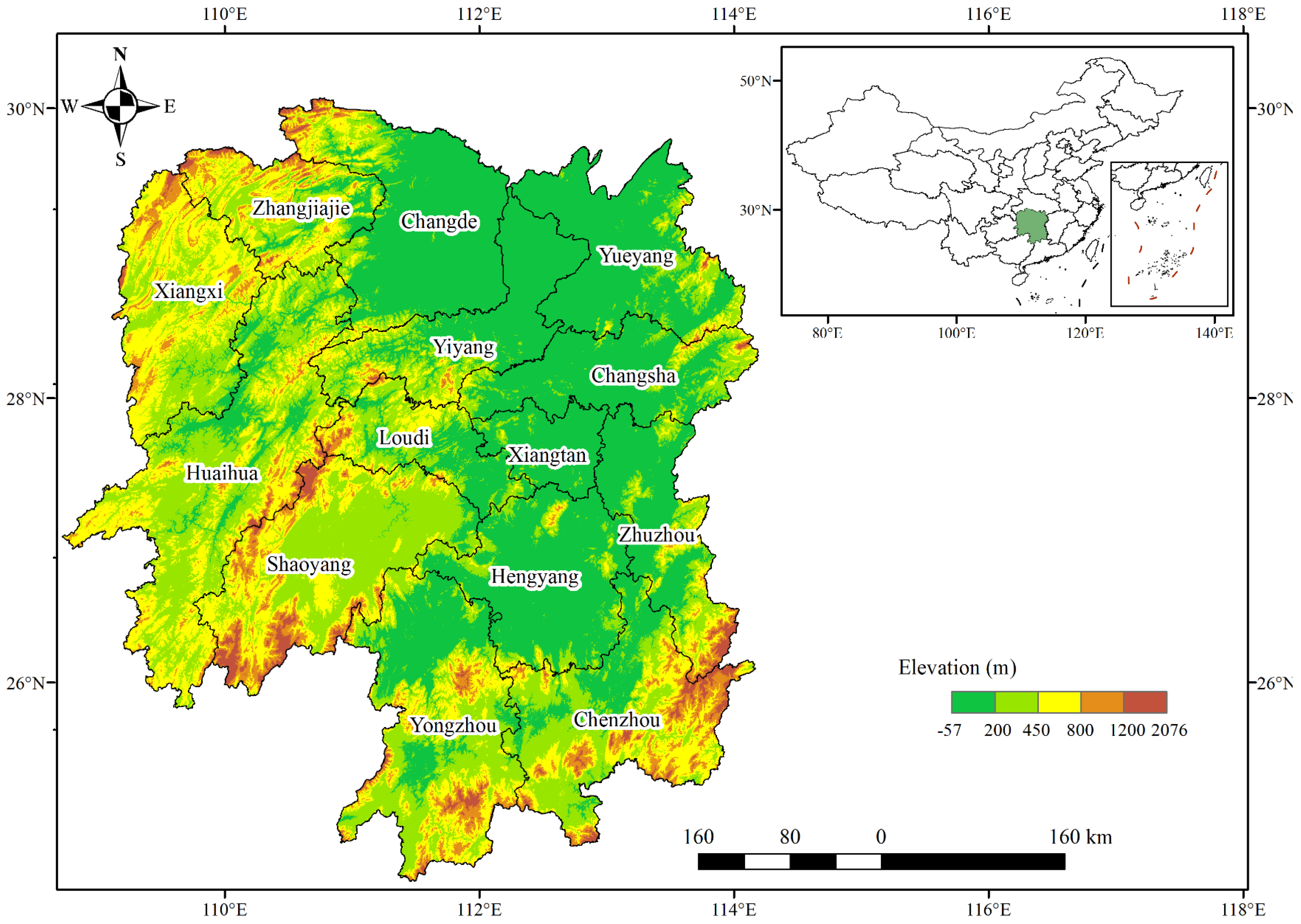
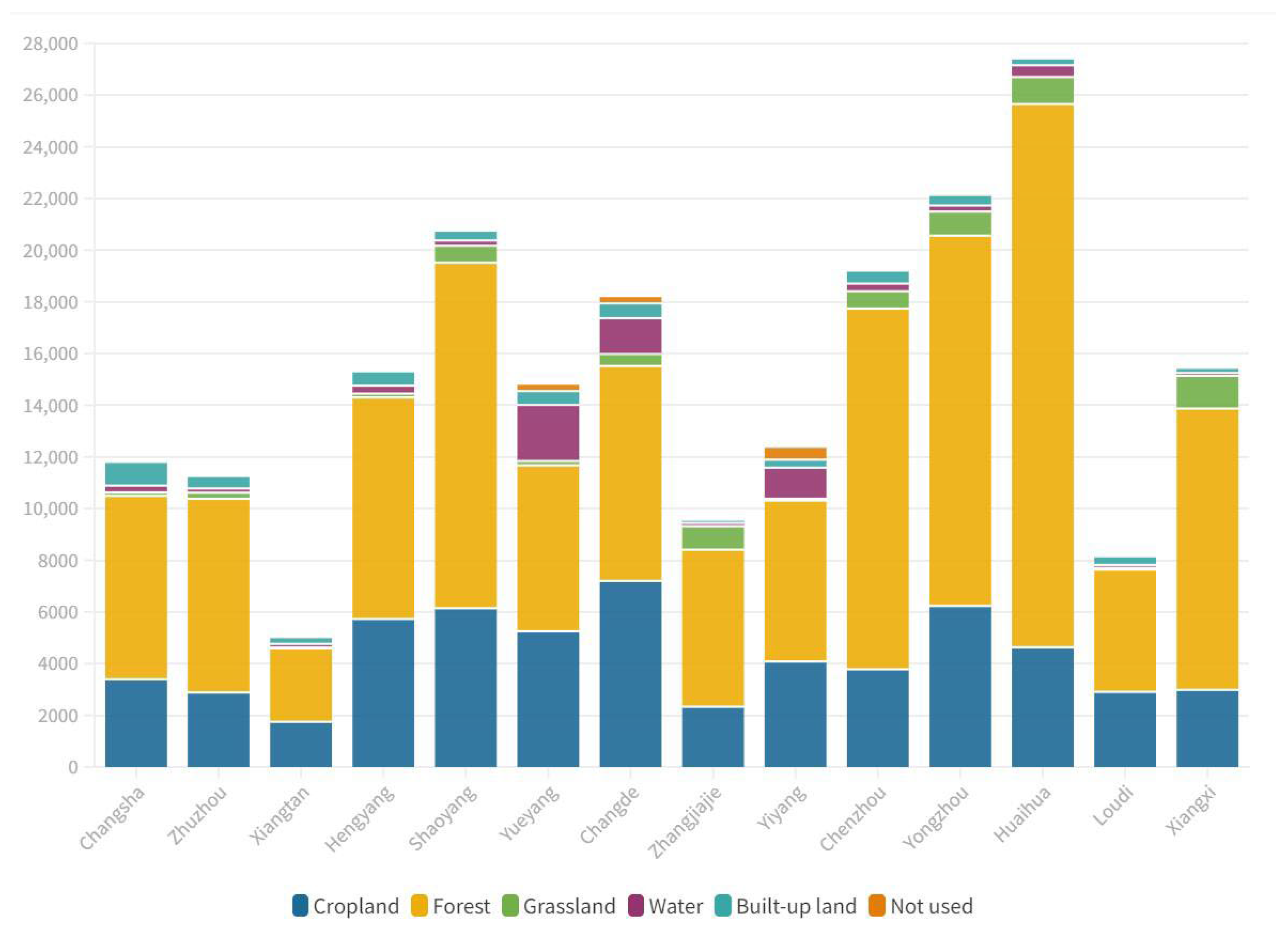

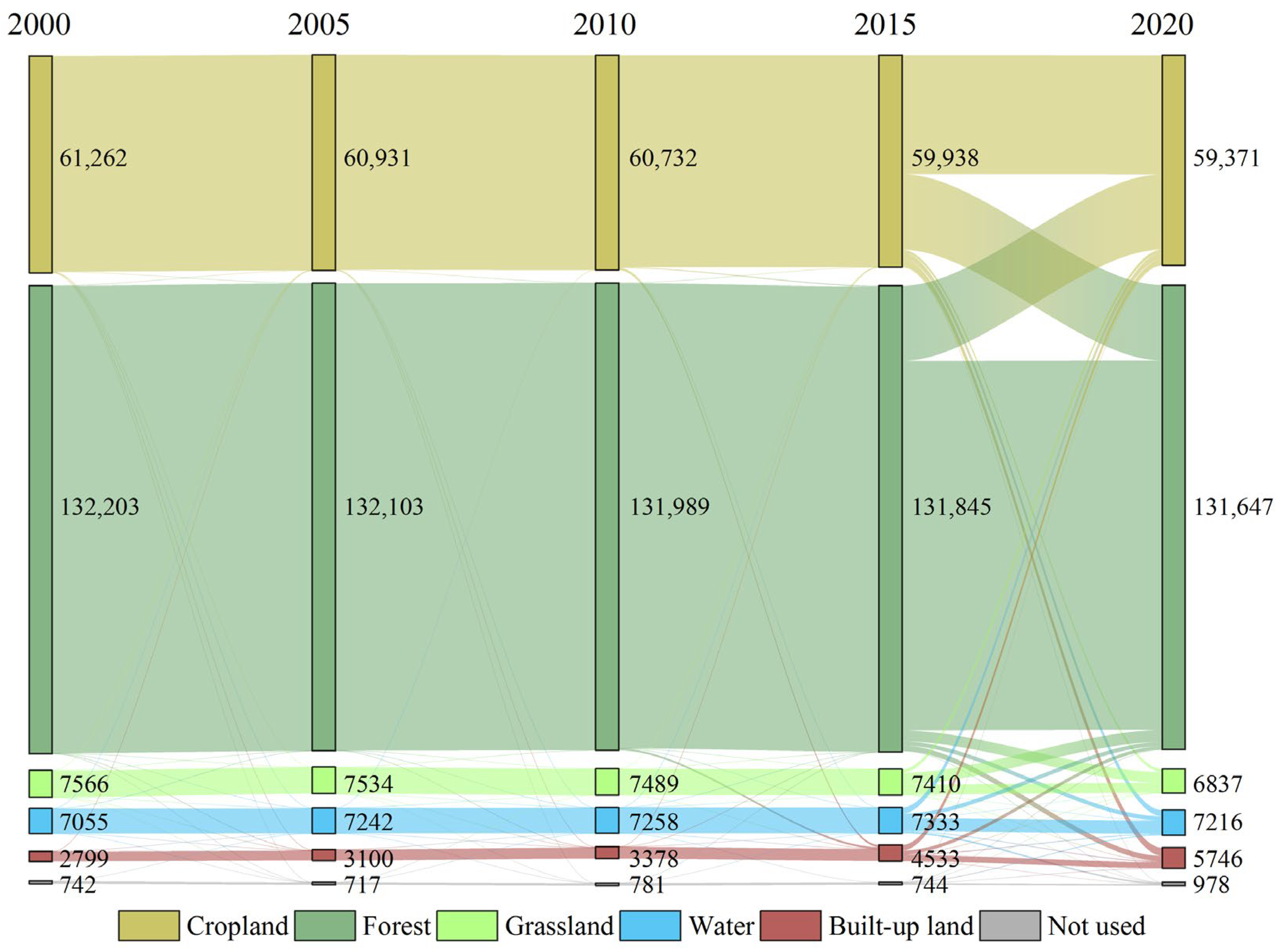
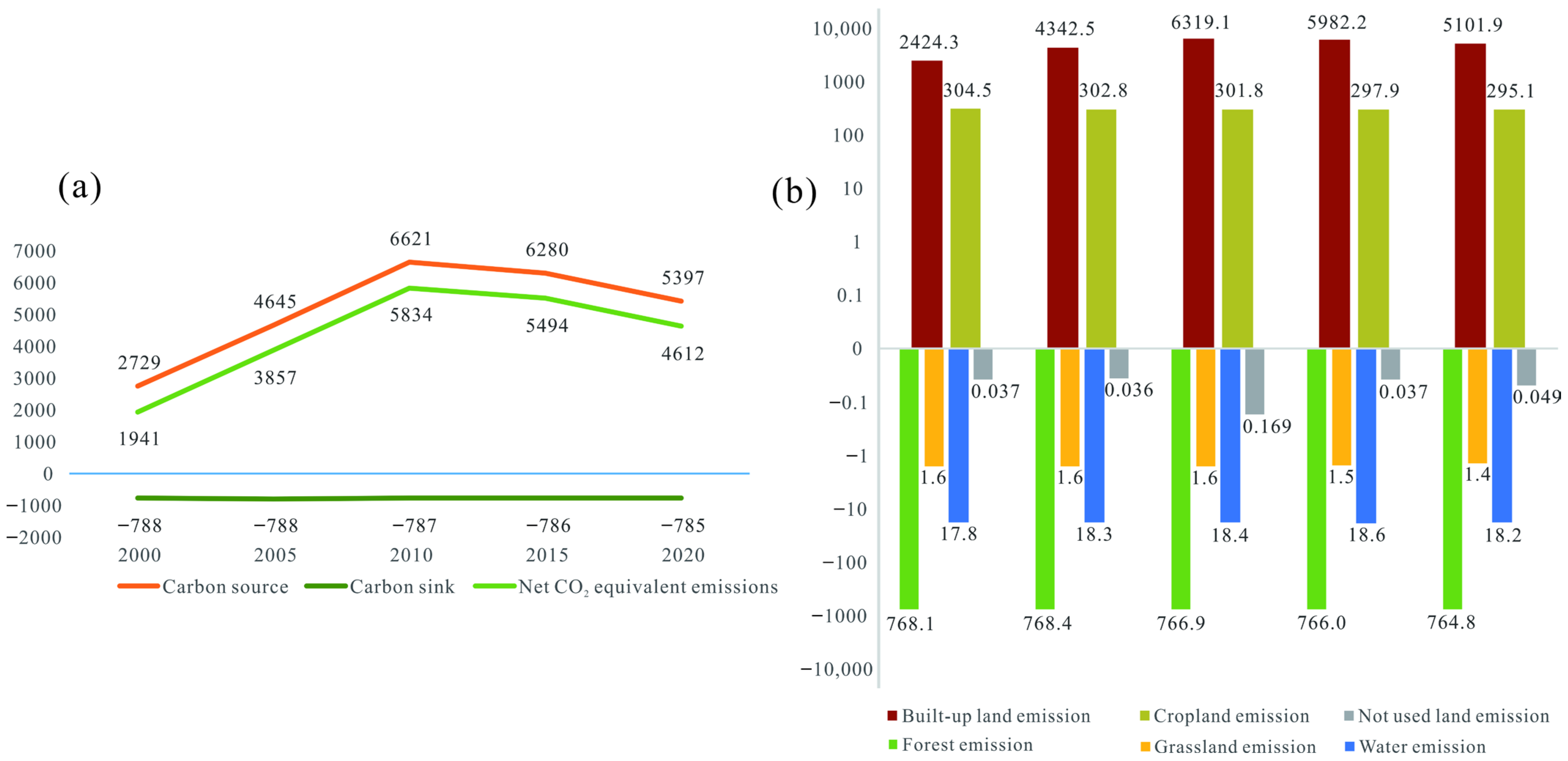
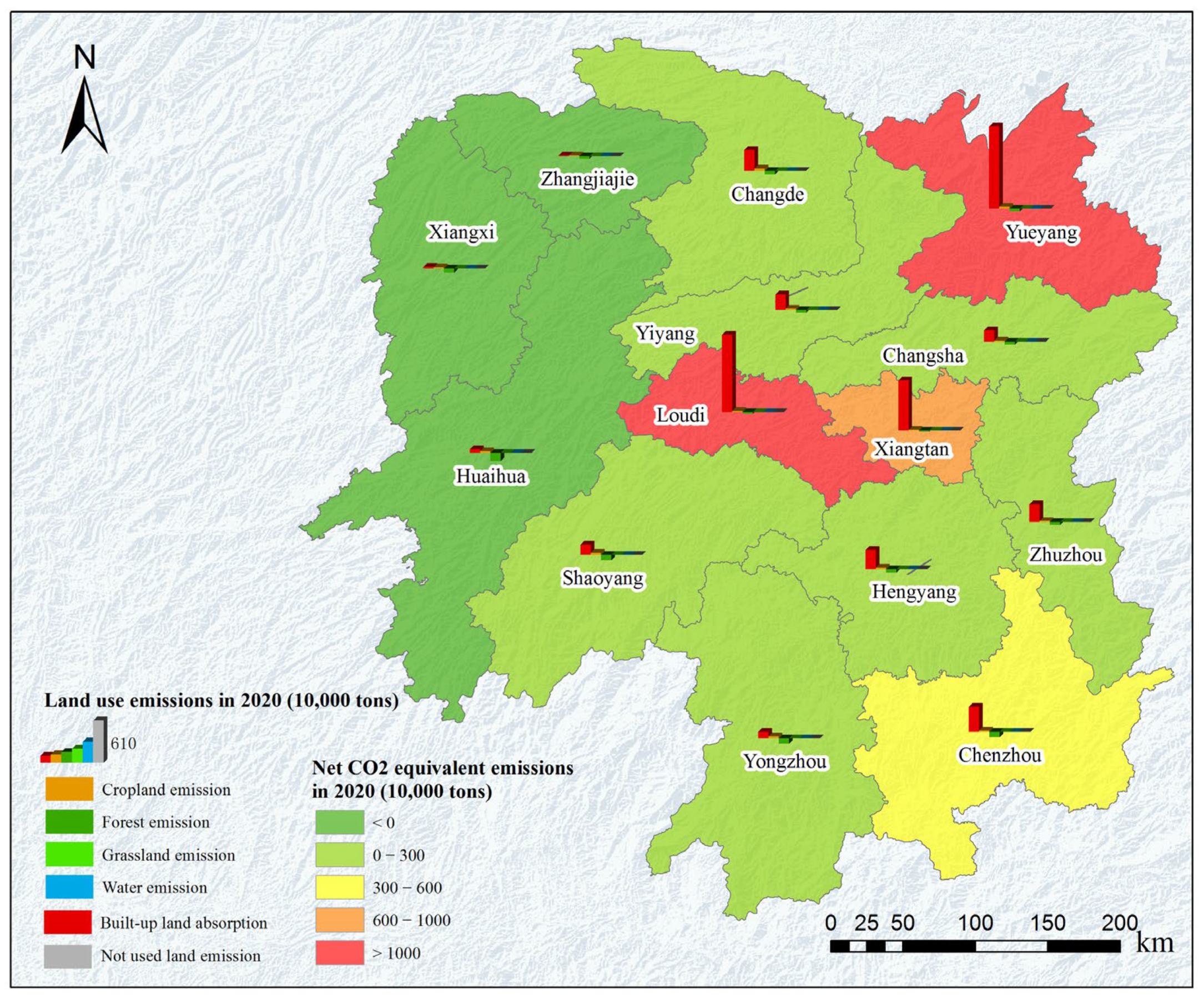

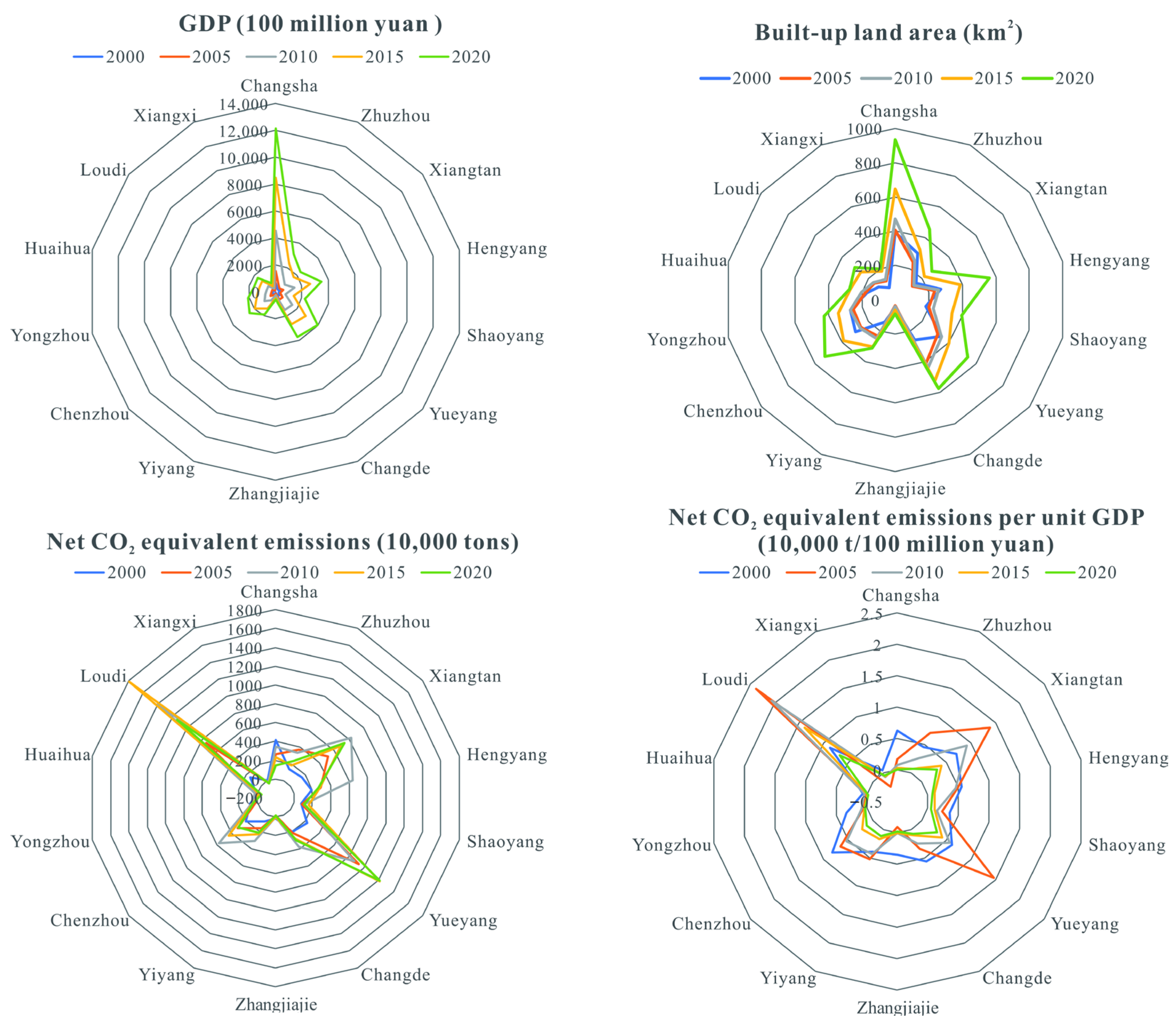
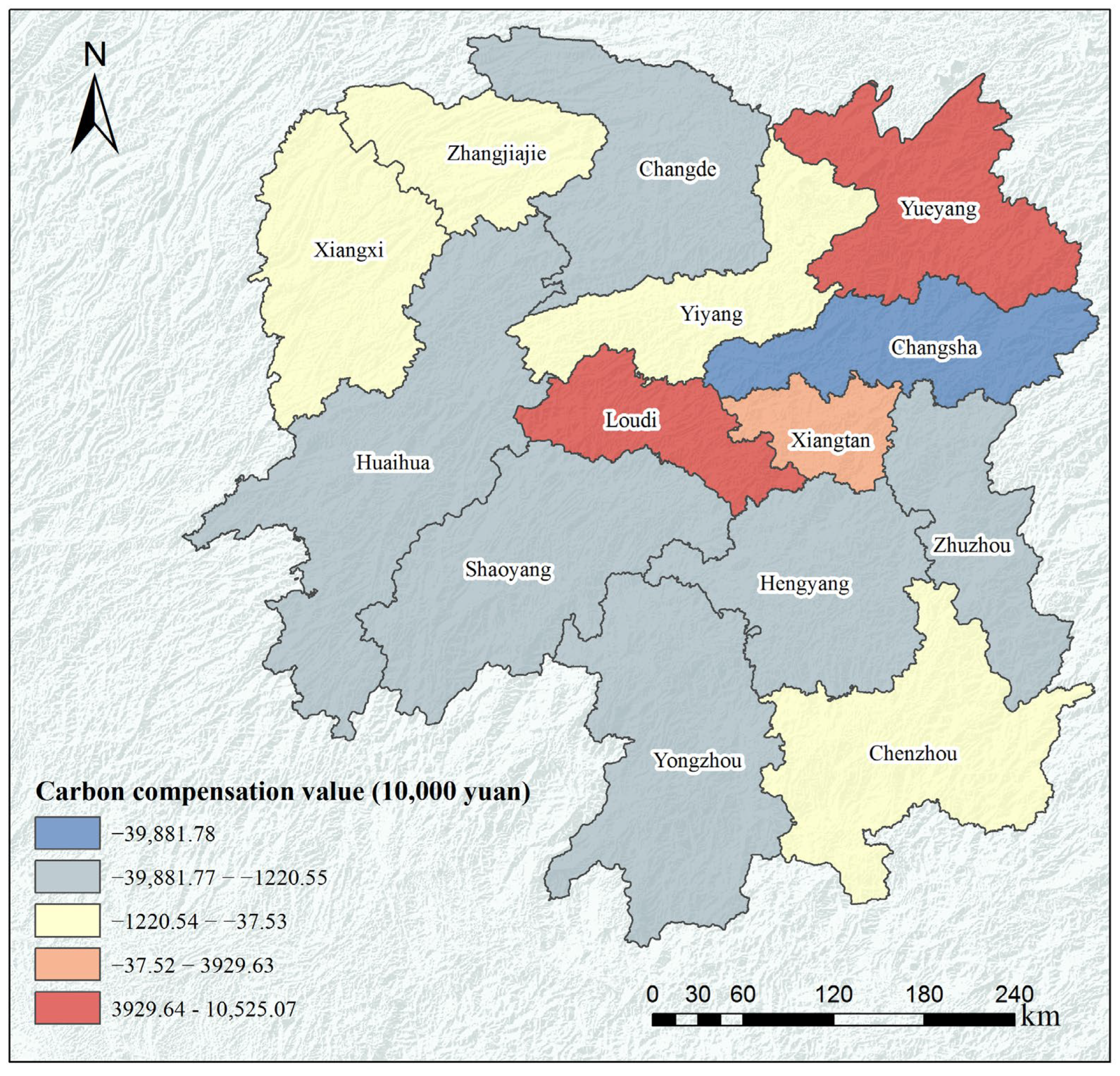
| Land Use Type | CO2 Equivalent Emission Coefficients (t·hm−2 year−2) | Reference |
|---|---|---|
| Cropland | 0.497 | [30,31,32] |
| Forest | −0.587 | [33,34] |
| Grassland | −0.021 | [35,36] |
| Water | −0.253 | [37,38] |
| Not used | −0.005 | [36,39,40,41] |
| Year | 2000 | 2005 | 2010 | 2015 | 2020 | Change Rate of Land Use from 2000 to 2020 |
|---|---|---|---|---|---|---|
| Cropland | 61,262 | 60,931 | 60,732 | 59,918 | 59,371 | −0.62% |
| Forest | 132,203 | 132,103 | 131,989 | 131,721 | 131,647 | −0.08% |
| Grassland | 7566 | 7534 | 7489 | 7389 | 6837 | −1.93% |
| Water | 7055 | 7242 | 7258 | 7324 | 7216 | 0.46% |
| Not used | 742 | 717 | 781 | 743 | 978 | 6.36% |
| Built-up land | 2799 | 3100 | 3378 | 4532 | 5746 | 21.06% |
| Cropland | Forest | Grassland | Water | Not Used | Built-Up Land | Transfer Rate | |
|---|---|---|---|---|---|---|---|
| Cropland | 34,041 | 21,683 | 859 | 1893 | 71 | 2678 | 44% |
| Forest | 21,300 | 104,410 | 3050 | 1213 | 15 | 1851 | 21% |
| Grassland | 1035 | 3465 | 2819 | 112 | 4 | 58 | 62% |
| Water | 1695 | 1127 | 43 | 3511 | 450 | 204 | 50% |
| Not used | 43 | 7 | 1 | 259 | 427 | 8 | 42% |
| Built-up land | 1164 | 506 | 20 | 161 | 4 | 945 | 66% |
| Year | Forest Emissions | Grassland Emissions | Water Emissions | Not Used Emissions | Built-up Land Emissions | Cropland Emissions | Carbon Removal | CO2 Equivalent Emissions | Net CO2 Equivalent Emissions |
|---|---|---|---|---|---|---|---|---|---|
| 2000 | −768.10 | −1.59 | −17.85 | −0.04 | 2424.32 | 304.47 | −787.57 | 2728.79 | 1941.22 |
| 2005 | −768.39 | −1.58 | −18.32 | −0.04 | 4342.46 | 302.83 | −788.33 | 4645.29 | 3856.96 |
| 2010 | −766.86 | −1.58 | −18.36 | −0.17 | 6319.13 | 301.84 | −786.96 | 6620.97 | 5834.00 |
| 2015 | −766.02 | −1.56 | −18.55 | −0.04 | 5982.19 | 297.90 | −786.16 | 6280.08 | 5493.92 |
| 2020 | −764.87 | −1.44 | −18.26 | −0.05 | 5101.89 | 295.07 | −784.61 | 5396.97 | 4612.36 |
| City | Changsha | Zhuzhou | Xiangtan | Hengyang | Shaoyang | Yueyang | Changde | Zhangjiajie | Yiyang | Chenzhou | Yongzhou | Huaihua | Loudi | Xiangxi |
|---|---|---|---|---|---|---|---|---|---|---|---|---|---|---|
| carbon compensation funds/104 yuan | −39,881.78 | −1220.55 | 3929.63 | −1427.29 | −1372.69 | 10,525.07 | −1353.26 | −672.52 | −317.94 | −37.53 | −1849.35 | −2008.47 | 7637.58 | −814.85 |
Disclaimer/Publisher’s Note: The statements, opinions and data contained in all publications are solely those of the individual author(s) and contributor(s) and not of MDPI and/or the editor(s). MDPI and/or the editor(s) disclaim responsibility for any injury to people or property resulting from any ideas, methods, instructions or products referred to in the content. |
© 2023 by the authors. Licensee MDPI, Basel, Switzerland. This article is an open access article distributed under the terms and conditions of the Creative Commons Attribution (CC BY) license (https://creativecommons.org/licenses/by/4.0/).
Share and Cite
Gu, H.; Liu, Y.; Xia, H.; Li, Z.; Huang, L.; Zeng, Y. Temporal and Spatial Differences in CO2 Equivalent Emissions and Carbon Compensation Caused by Land Use Changes and Industrial Development in Hunan Province. Sustainability 2023, 15, 7832. https://doi.org/10.3390/su15107832
Gu H, Liu Y, Xia H, Li Z, Huang L, Zeng Y. Temporal and Spatial Differences in CO2 Equivalent Emissions and Carbon Compensation Caused by Land Use Changes and Industrial Development in Hunan Province. Sustainability. 2023; 15(10):7832. https://doi.org/10.3390/su15107832
Chicago/Turabian StyleGu, Huangling, Yan Liu, Hao Xia, Zilong Li, Liyuan Huang, and Yanjia Zeng. 2023. "Temporal and Spatial Differences in CO2 Equivalent Emissions and Carbon Compensation Caused by Land Use Changes and Industrial Development in Hunan Province" Sustainability 15, no. 10: 7832. https://doi.org/10.3390/su15107832






